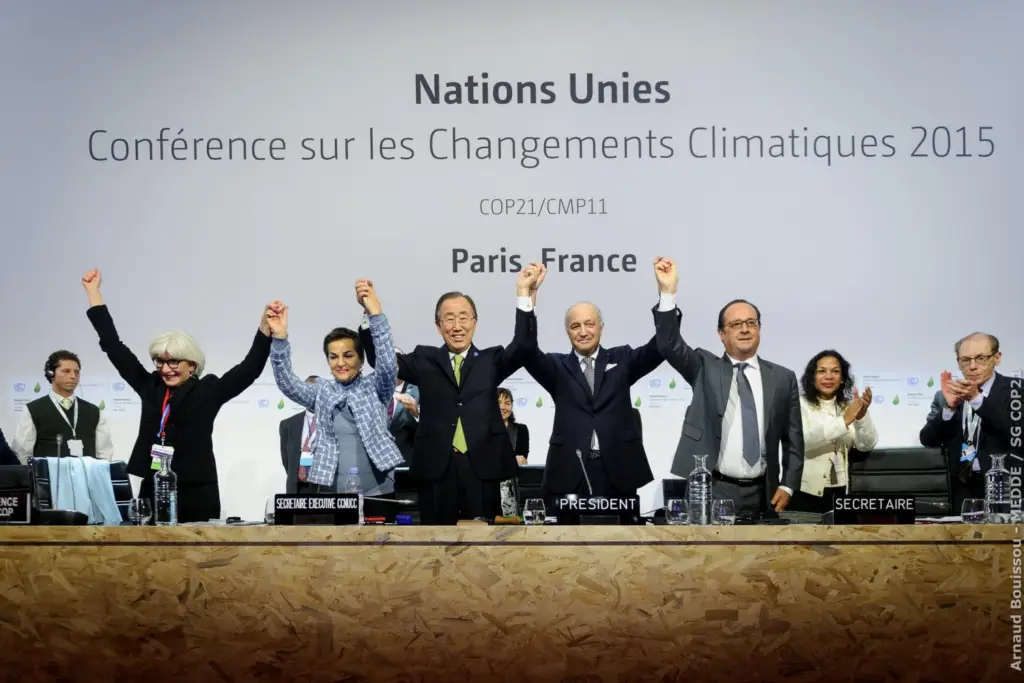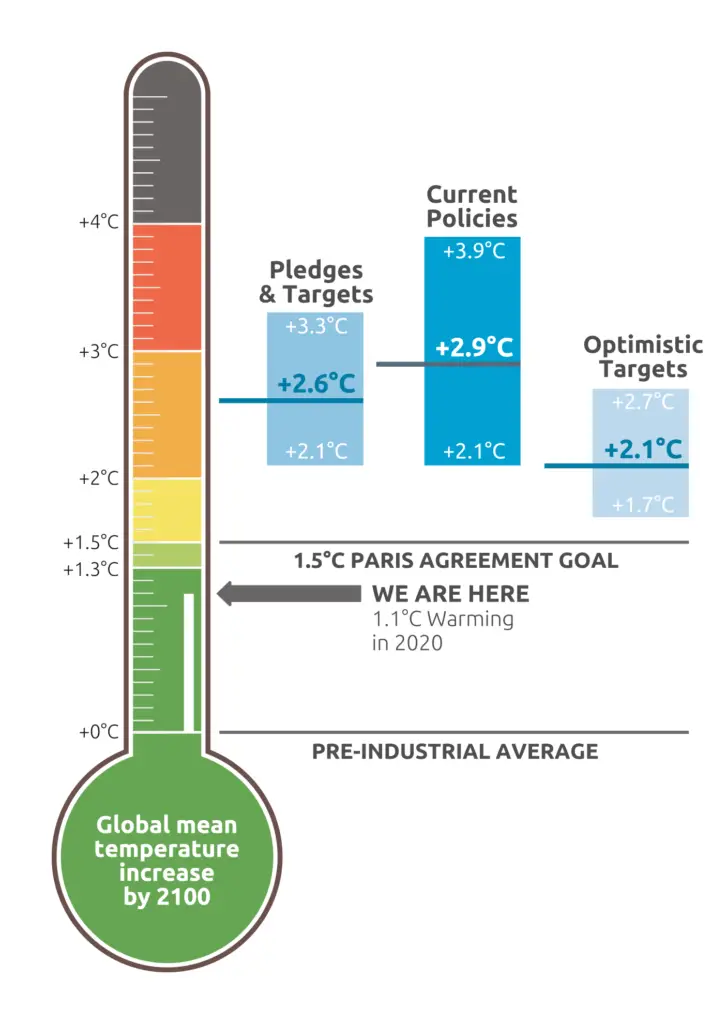Since the 1970s, the issue of climate change has become a headline topic. Scientists have argued that global warming caused by human practices began in the 19th century. There may be little evidence to show when global warming actually began; however, one prevalent truth is that the world has become 1.1 degrees warmer than it was 2 centuries ago.
In 2015, world leaders reached an agreement to adopt the Paris Climate Accord under the UN’s framework on climate change. The meeting which lasted two weeks in Paris sought to discuss and finalise ways to mitigate threatening climate change by limiting global warming.
The Paris Climate Accord seeks a more balanced environment where global warming can be reduced to the best possible minimum. In this article, We will talk about what the Paris agreement is and highlight some of the pros and cons of the agreement.
What is the Paris climate accord?

The Paris Climate Accord also known as the Paris agreement is a legally binding agreement between the world’s governments to reduce the levels of carbon emissions.
The framework of the agreement was set up during COP 21 (Conference of the Parties) held in 2015 at the capital of France. It has been ratified by over 190 countries since its inception. The key aspects of the Paris agreement are as follows:
- To limit global temperature from rising by more than 2 degrees above pre-industrial levels. Discussions about efforts to limit it to 1.5 degrees in the future was also raised.
- To prepare and maintain a nationally determined contribution (NDC) of annual mitigations to be communicated every half decade by participating countries.
- To conserve carbon sinks and reservoirs including forests.
- To formulate and implement plans for adaptation and enhance the adaptive capacity of participating nations.
- To minimise loss caused by the effects of climate change and improve resilience.
- To support developing countries in areas of finance, technology and capacity building.
- To improve climate change education, training and information.
Pros of the Paris Climate Agreement
1. It tackles the global warming problem

Global warming has become a threat to not just our environment but also to our livelihoods. Extreme heat waves, droughts and floods are likely to become the norm if global warming is left unchecked.
The Paris agreement takes a revolutionary step toward tackling what is unarguably the most important issue of our time. Its aim to limit global temperatures increase to below 2 degrees is a healthy step toward the race to zero.
You may argue that having a 2-degree increase mark is insignificant compared to how drastically temperatures have risen over the years but it is surely a realistic way to begin the race.
See also: How does planting trees help climate change?
2. COP21 has more international involvement and support
Compared to earlier climate treaties, the COP21 has gained more international support and involvement than any other climate treaty. Unlike the Kyoto protocol of 1997 where about 37 industrialized nations signed a treaty to limit GHG emissions, COP 21 encourages the support and involvement of over 190 countries.
Even though developed countries contribute more than half of GHG emissions, developing countries may produce as much GHG in the future as they keep advancing to make the life of their citizens better.
This is why it is important that developing countries join in on the treaties ensuring that global warming issues are handled. This way, they can already adapt to the challenges that may arise from climate change mitigation and easily go through it.
Through the NDC, each country is able to set achievable goals toward climate change mitigation and carry out these goals. COP21 also set a monitoring committee that will help facilitate the implementation of these goals.
3. The Paris climate accord can create more jobs by 2030

The International Labour Organisation in 2021 states that the Paris agreement can lead to the creation of about 18million jobs. A study by the World Bank conducted in 2013 showed that more jobs were created through renewable energy investment than oil and gas.
As more people seek out alternative energy sources, a shift towards renewable energy can create more job opportunities.
4. COP21 is compatible with other environmentally friendly aims
The Paris Climate Accord abides by the UN’s sustainable goal 13; climate action. This goal links to other SDGs which have been set up to improve the lives of the people, the planet and create prosperity for all.
SDGs 7 (Affordable and clean energy), 9 (Industry innovation and infrastructure), 12 (responsible consumption and production) and 15 (Life on land) are some of the SDG’s that link directly to Climate action.
COP 21 has the aim of ensuring that greenhouse gases are mitigated to avoid flooding and other natural disasters that could be a threat to life on land. Creating clean energy, innovative industry and responsible production can help in limiting GHG emissions.

5. Paris Climate Accord gained support from big stakeholders
The Paris agreement has gained support from big businesses and companies including Tesla, Shell, Coca-cola, etc in their effort to limit global warming. Companies are pretty much aware that if they fail to address issues of climate change it may be detrimental to our future.
Also read: What is Employee Green Behavior? It’s not what you think
Cons of the Paris Climate Accord
1. The COP21 has no robust enforcement mechanism

The world has reached a place where coercion is at its minimum. This is true for most areas of the current world including the Paris Agreement. The COP even with its claim of being legally binding does not have sanctions set for defaulting countries. This means that countries that do not fulfill their NDC set goals will face no sanctions.
While this is a plus for freedom, it could also mean that some countries may have their set-out plans written on paper and left there without any real effort to implement them. Consequently, it could mean that we are chasing shadows if only a few countries are left to be responsible for mitigating GHG emissions.
2. Independent rules can make it difficult to reach set goals.
The Paris agreement has a set structure under Article 4 called the Nationally Determined Contribution (NDC). Under this structure, countries can independently set mitigation targets for themselves. Although these targets are supposed to be communicated and improved upon every 5 years, it still leaves worries about how much some countries are willing to achieve.
Such structure could mean that some countries with higher emissions may be making very few changes in comparison with other countries. This may not be good for the overall objective of the Paris agreement.
3. The main goal of the Paris climate accord has proved unrealistic
The Paris agreement seeks to see that world temperature does not increase more than 2 degrees compared to pre-industrial levels. This is great but how achievable has it been?
In 2021, the UNFCCC released a report showing how NDCs were unable to meet set goals for the Paris agreement. The report showed that changes by countries to limit GHG emissions have been small and could be less than 1% in 2030 compared to 45% speculated by the Paris agreement.

This shows that the 2015 agreement, though reasonable, may take us a really really long time before it becomes a reality. But for now, we are still falling short.
4. No carbon tax
Many companies that use fossil fuel for production do so because it is a cheaper option when compared to making the shift to renewable energy. While governments, businesses, and individuals alike make changes to reduce man-made climate change, these companies keep increasing their carbon footprint.
Calculate your carbon footprint here
The Paris agreement made no provisions to ensure that these companies pay for their emissions. Such oversights could lead to more carbon footprints as companies using fossil fuels will end up seeing their choice as a cheaper option.
Conclusion
The Paris climate agreement has been a long time coming, and it was a very long process that took us to where we are at. There are several arguments for and against the agreement. However, the agreement is still being implemented and progress is being made no matter how little.
Whether or not the Paris Agreement will be able to meet its goals remains in question.
Nevertheless, the bottom line is that we need to commit ourselves to a plan like this with more passion. Doing this could change the course of history and leave us on a better path.
Related posts:
- Harnessing the Power of the Sun: A Guide to Solar Installation - February 12, 2024
- Vacuum Trucks: The Unseen Heroes of Waste Management and Their Environmental Benefits, Featuring McDonald Farms - December 11, 2023
- Satellites And Climate Adaptation: Solutions From Space - December 1, 2023






